There are more fish whose English common names start with the letter Z than you might think – over 50, in fact! And while it’s true that a bunch of those are just named after the most popular Z animal of them all, the zebra, there are plenty more! Read on for the full list.
note on fish measurements: “SL” = Standard Length (does not include tail), “TL” = Total Length (includes tail)
1. Zabaleta Anchovy (Anchovia clupeoides)
This marine and brackish tropical anchovy species is native to the Western Atlantic Ocean from the Gulf of Mexico and the Caribbean Sea down to the Central and South American coast to Brazil. This fish inhabits shallow coastal waters, mangroves, and estuaries, and thus tolerates brackish and sometimes even fresh water. It is a plankton filter feeder and can grow up to 30.0 cm TL.
2. Zaca Blenny (Malacoctenus zacae)
This marine tropical species is native to the Pacific coast of Mexico from Baja California to Acapulco. It feeds on invertebrates and can grow to 6.5 cm TL.
3. Zacapu Allotoca (Allotoca zacapuensis)
This freshwater splitfin is endemic to Zacapu, Michoacán, Mexico. It inhabits turbid water with muddy bottoms where it can then hide in vegetation, and it can grow to 3.0 cm TL. The IUCN also currently lists this species as Critically Endangered.
4. Zaire Lampeye (Hypsopanchax platysternus)
This freshwater tropical poeciliid is native to both the middle and upper Congo River basin in Africa. It inhabits clear forest rivers and brooks and can grow to 5.5 cm TL. It is also sometimes found in the aquarium trade.
5. Zambezi Bream (Pharyngochromis acuticeps)
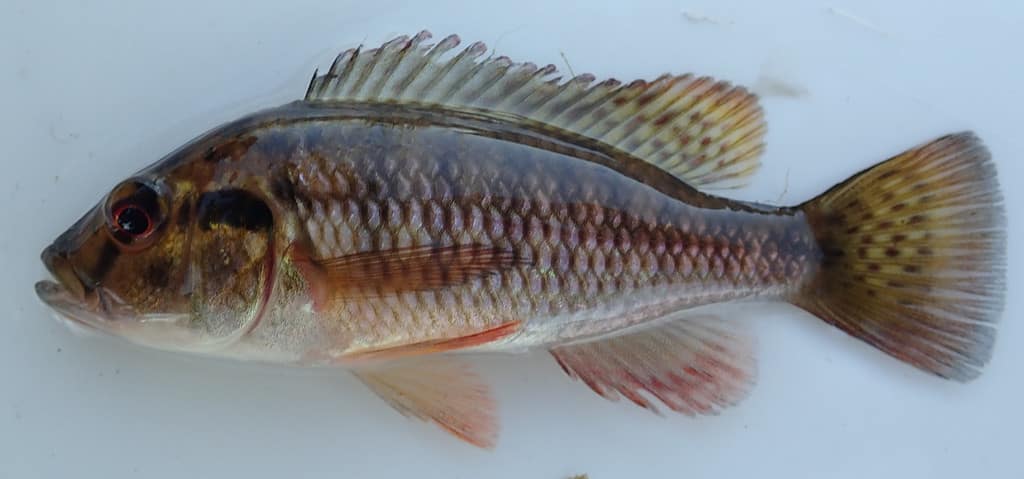
The Zambezi Bream is one of the “mouthbrooding” cichlids, with females keeping their clutch of eggs tucked away in their mouths until they hatch.
©Robert Taylor / CC BY 4.0 – License
This freshwater cichlid is native to the Zambezi, Save-Runde, Kunene, Okavango, and Quanza River systems in Southern Africa. It is notable for being one of the ovophilic cichlid species — the female broods the eggs in her mouth! It occurs in a wide range of habitats and can grow to 12 cm TL.
6. Zambezi Grunter (Parauchenoglanis ngamensis)
This freshwater catfish is native to the Kasai, Okavango, and upper Zambesi River systems in Central and Southern Africa. It feeds on both small fish and invertebrates and can grow up to 38.0 cm SL.
7. Zambezi Happy (Pharyngochromis darlingi)
This freshwater tropical cichlid is native to the Okavango, upper Save-Runde, Zambezi, and Kunene River systems in Southern Africa. It feeds on aquatic insects and crustaceans as well as small fish and can grow to 22.0 cm TL.
8. Zambezi Parrotfish (Cyphomyrus discorhynchus)
This freshwater tropical elephantfish is native to several river and lake systems across both Central and Southern Africa. It is a nocturnal shoaling fish that feeds on insect larvae and benthic invertebrates, and it can grow up to 31 cm SL.
9. Zamora Woodcat (Auchenipterichthys coracoideus)
This freshwater tropical catfish is endemic to the Amazon River basin in Peru, where it can grow to 19.2 cm SL. It can also be found in the aquarium trade.
10. Zamurito (Calophysus macropterus)
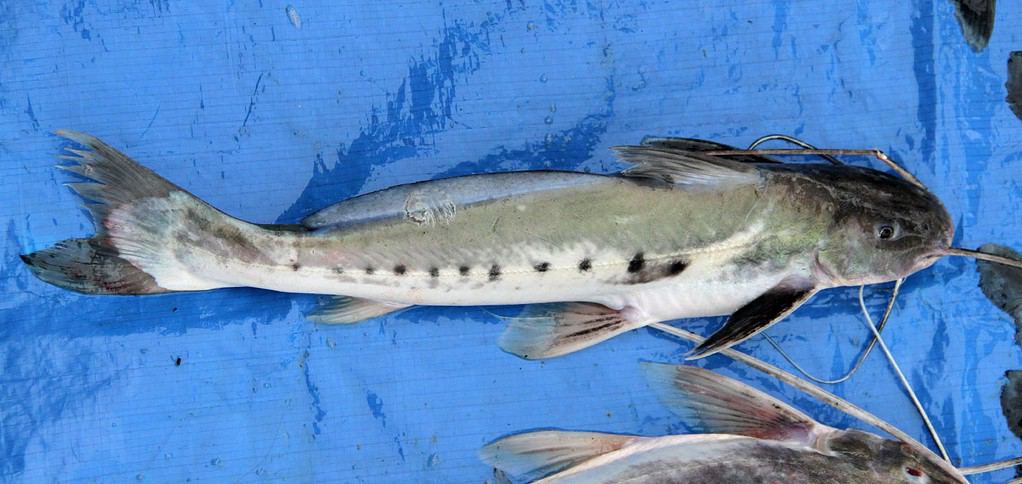
The zamurito is also known as the vulture catfish, as it is reported to commonly dine on fishermen’s catches.
©Clinton & Charles Robertson / CC BY 2.0 – License
This freshwater tropical catfish is native to both the Amazon and Orinoco River basins in South America, where it can grow up to 40.0 cm TL. It is also present in the aquarium trade.
11. Zander (Sander lucioperca)
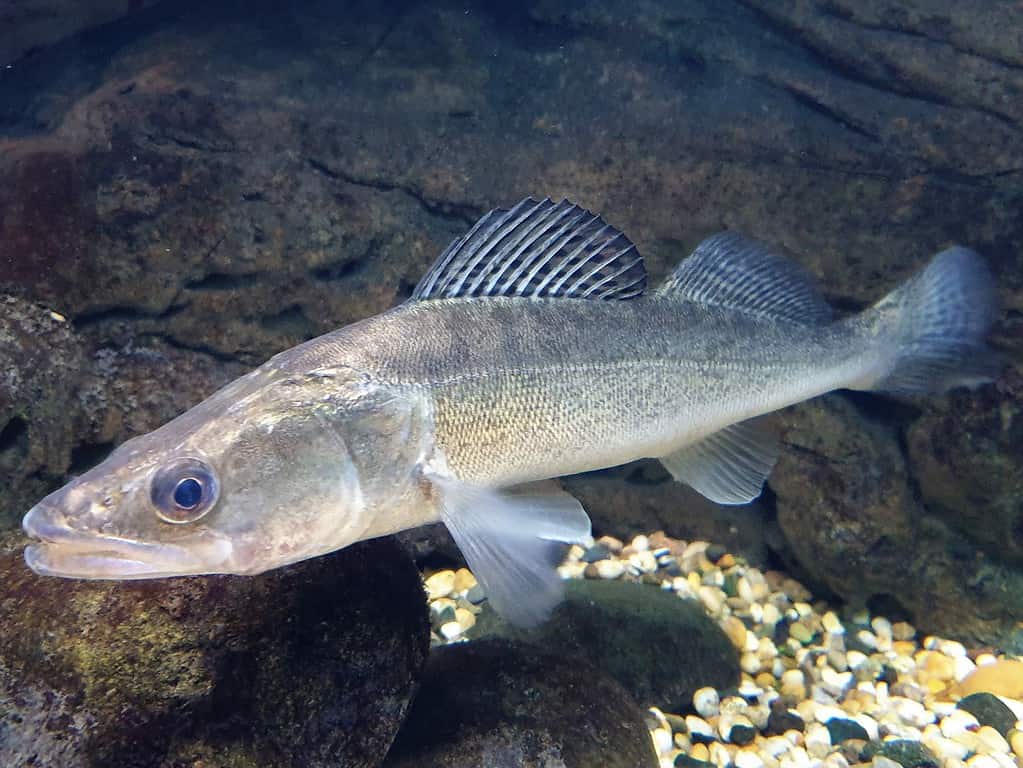
The Zander is a popular game fish, and has thus been introduced widely beyond its native range.
©Emőke Dénes / CC BY-SA 4.0 – License
This freshwater and brackish perch is native to the Caspian, Baltic, Black, and Aral Sea basins, as well as the Elbe (North Sea basin) and Maritza (Aegean Sea basin) River drainages. Additionally, humans have introduced it widely elsewhere as a popular sport fish. This, in turn, leads it to become invasive and cause adverse ecological impacts in some areas. This is a predatory species that feeds on other fishes and can eventually grow up to 100.0 cm SL.
12. Zanzibar Barb (Enteromius zanzibaricus)
This freshwater tropical cyprinid is native to rivers of both Kenya and Somaliland in Africa, where it can grow to 9.7 cm TL.
13. Zanzibar Butterflyfish (Chaetodon zanzibarensis)
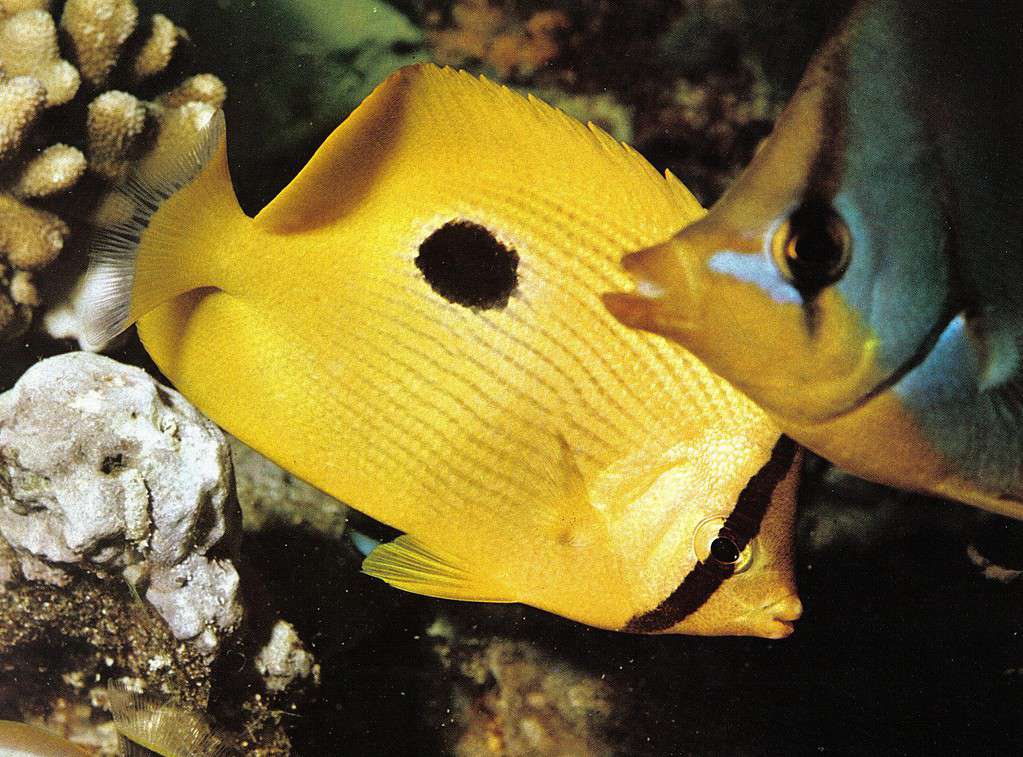
The Zanzibar butterflyfish is a bright yellow fish that sports a single spot and stripe.
©Photography by Dino Sassi – Marcel Fayon, Photo Eden LTD / CC0 – License
This marine tropical reef species is native to the Western Indian Ocean from eastern to southern Africa and Madagascar as well as nearby oceanic islands. It feeds on live corals and can grow to 12.0 cm TL. It is also available in the aquarium trade.
14. Zanzibar Guitarfish (Rhinobatos zanzibarensis)
This marine tropical ray is endemic to the Western Indian Ocean around Tanzania. It is a benthic species that inhabits inner continental shelf waters and can eventually grow up to 75.0 cm TL. The IUCN also currently lists this species as Near Threatened.
15. Zanzibar Tonguesole (Cynoglossus zanzibarensis)
This marine tropical flatfish is native to the Western Indian Ocean in shallow waters from Kenya to South Africa. It feeds on small invertebrates and can grow up to 32.0 cm TL.
16. Zavora Pipefish (Halicampus zavorensis)
This marine tropical species is native to the Western Indian Ocean around both Mozambique and Oman. Like other pipefish, this species is ovoviviparous, with the males carrying the eggs and then hatching live young. It can grow to 10 cm TL.
17. Zebra Blenny aka Zebra Rockskipper (Istiblennius zebra)
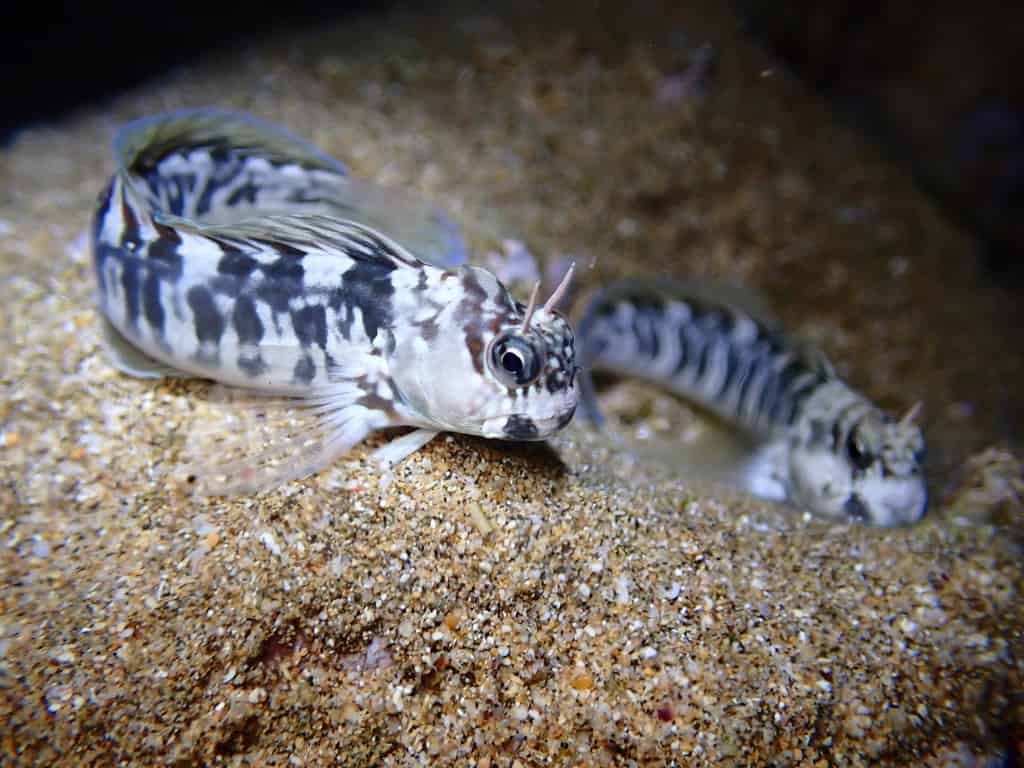
Like the other “zebra” fish that follow, this fish gets its common name from its stripey dark/light pattern.
©Cricket Raspet / CC BY 4.0 – License
This marine tropical reef species is endemic to tide pools of the Hawaiian Islands. This blenny is notable for its impressive leaping ability. This little fish can jump from pool to pool as needed, and briefly breathes air as it does so! It feeds on both benthic algae and detritus and can grow to 19.3 cm (male) and 14.1 cm (female) SL. It is also found in the aquarium trade.
18. Zebra Bullhead Shark (Heterodontus zebra)

A zebra bullhead shark at the Beijing Aquarium shows off its stripes.
©Jason Quinn / CC BY-SA 3.0, via Wikimedia Commons – License
This marine subtropical reef shark is native to the Western Pacific Ocean from Japan and Korea down to northwestern Australia and Queensland. It can eventually grow up to 125 cm TL.
19. Zebra Catfish (Brachyplatystoma juruense)
This freshwater tropical species is native to both the Amazon and Orinoco River basins in South America, where it can grow to 60 cm TL.
20. Zebra Clingfish (Tomicodon zebra)
This marine tropical species is native to the Eastern Central Pacific Ocean from southern Baja California and the eastern Gulf of California, including the Tres Marias Islands, to southern Mexico. It lives in rocky areas, where it is capable of facultative air-breathing. It feeds mainly on barnacles and small crustaceans and can grow to 6.0 cm.
21. Zebrafish aka Zebra Danio (Danio rerio)
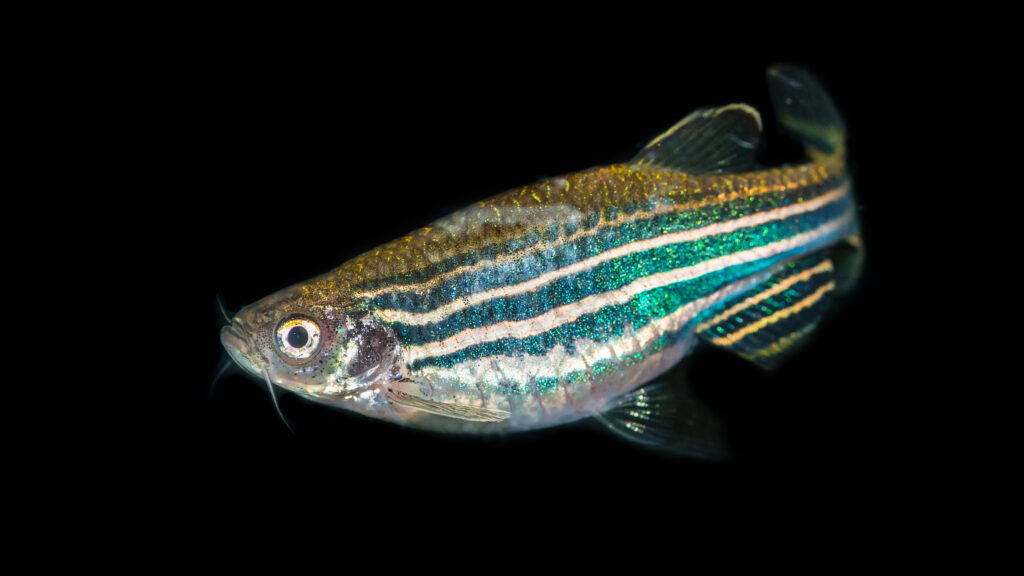
The zebrafish is a popular choice for freshwater tropical aquariums.
©Ian Grainger/Shutterstock.com
This freshwater tropical fish is native to South Asia, including Pakistan, India, Pakistan Bangladesh, Nepal, Myanmar, and Bhutan, where it can grow to 3.8 cm SL. This fish is also popular in the aquarium trade and has been accidentally introduced to the U.S. and Columbia via escaped/released captive fish.
22. Zebra Garden Eel (Heteroconger polyzona)

Like other garden eels, the zebra garden eel looks like it is growing out of the ground!
©Lakshmi Sawitri / CC BY 2.0 – License
This marine tropical species is native to the Indo-West Pacific region, including the Ryukyu Islands, Philippines, Indonesia, Papua New Guinea, and Vanuatu. It is a colonial species that lives in burrows and can grow up to 34.7 cm TL.
23. Zebra Lionfish aka Zebra Turkeyfish (Dendrochirus zebra)

A gorgeous zebra
lionfish
from Bali, Indonesia. Watch out for those venomous spines!
©Sakis Lazarides/iStock via Getty Images
This marine tropical reef fish is native to the Indo-West Pacific region, including the Red Sea. While the 13 dorsal spines are venomous, the flesh is not poisonous and is edible. It can grow to 25 cm SL. It is also popular in the aquarium trade and at public aquariums.
24. Zebra Loach (Botia striata)
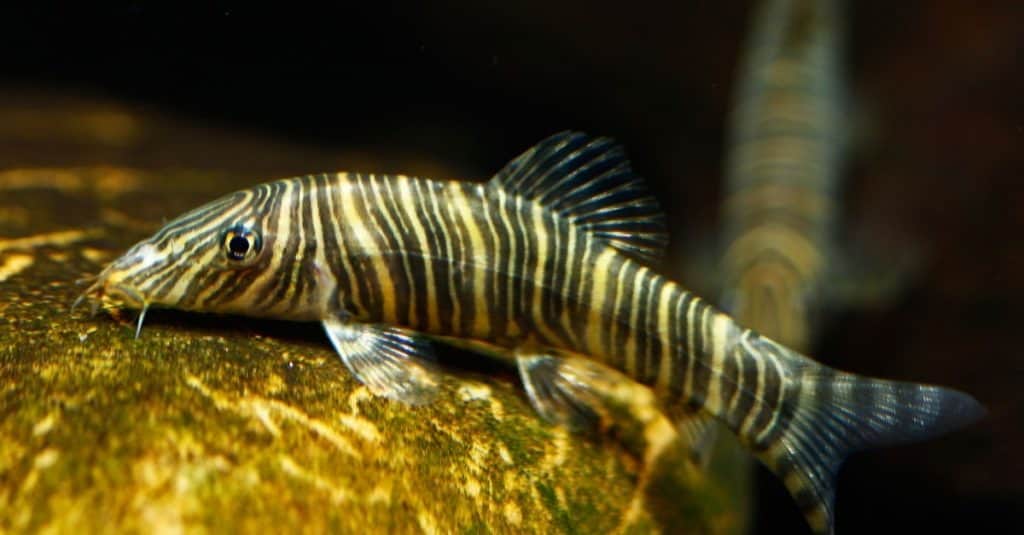
This peaceful fish is bred in captivity for freshwater community tanks, but in the wild, it’s listed as an endangered species.
©Pavaphon Supanantananont/Shutterstock.com
This freshwater tropical species is endemic to both the Western Ghats and Maharashtra, India. It inhabits clear mountain streams and can grow to 7.8 cm SL. While this fish is also available in the aquarium trade, the IUCN currently lists the wild species as Endangered.
25. Zebra Moray (Gymnomuraena zebra)
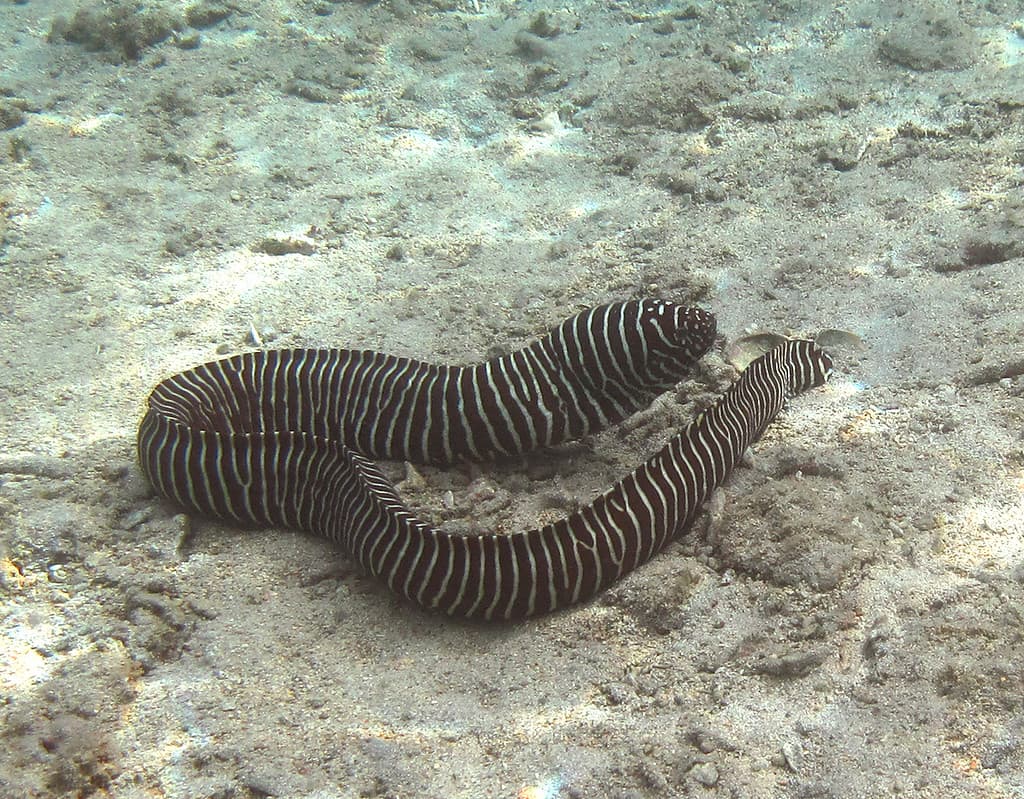
The zebra moray boasts black and white stripes from head to tail.
©Philippe Bourjon / CC BY-SA 3.0 – License
This marine tropical reef moray eel is widespread throughout the Indo-Pacific region. It is a benthic species that feeds primarily on xanthid crabs as well as other crustaceans, mollusks, and sea urchins, and it can eventually grow up to 150 cm TL. It is also present in the aquarium trade.
26. Zebra Oto (Otocinclus cocama)
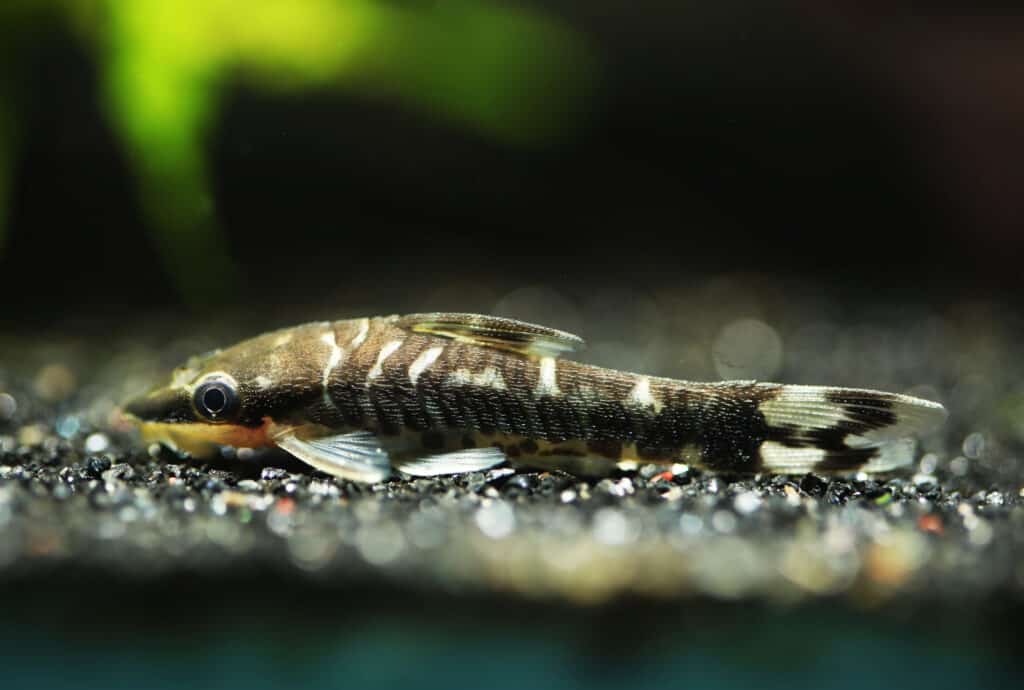
The zebra oto was not described as a species until 2004, but it is sadly already listed as an endangered species.
©Pavaphon Supanantananont/Shutterstock.com
This freshwater tropical catfish is endemic to rivers in Peru. It is capable of facultative air-breathing and can grow to 4.4 cm SL. This species has been in the aquarium trade since the 1990s, but it was not scientifically described as a species until 2004, and the IUCN currently lists it as Endangered.
27. Zebra Perch Sea Chub (Kyphosus azureus)
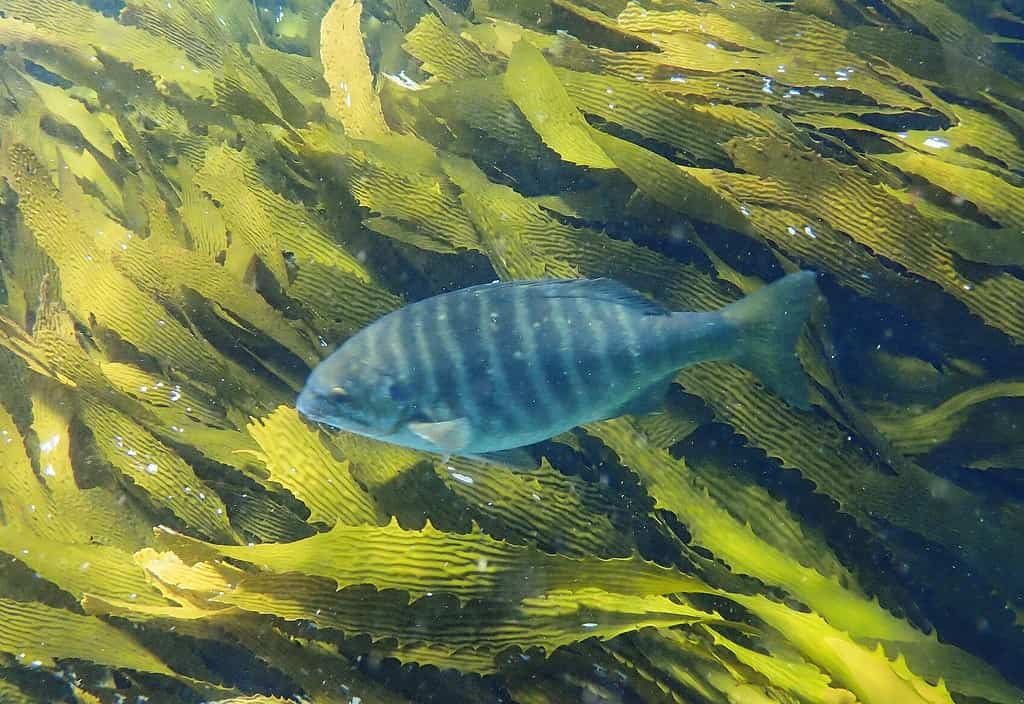
A zebra perch sea chub grazes on vegetation.
©Donald Davesne, CC BY 4.0, via Wikimedia Commons – License
This marine subtropical species is native to the Eastern Central Pacific Ocean from Monterey Bay in California, USA to the Gulf of California in Mexico. It is herbivorous and can grow up to 45.0 cm TL.
28. Zebra Pleco (Hypancistrus zebra)
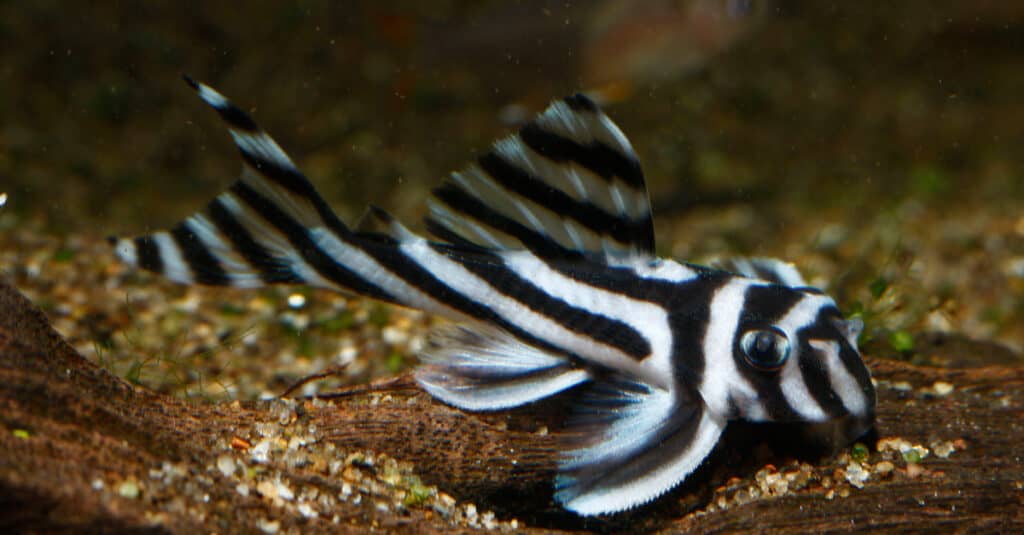
The zebra pleco certainly earns its name with these bold black and white stripes.
©Pavaphon Supanantananont/Shutterstock.com
This tropical freshwater catfish is endemic to the Xingu River basin in Brazil. The female deposits the eggs into caves, which are then guarded by the male. It grows to 7.0 cm TL. The IUCN also currently lists this species as Critically Endangered.
29. Zebra Seabream (Diplodus cervinus)
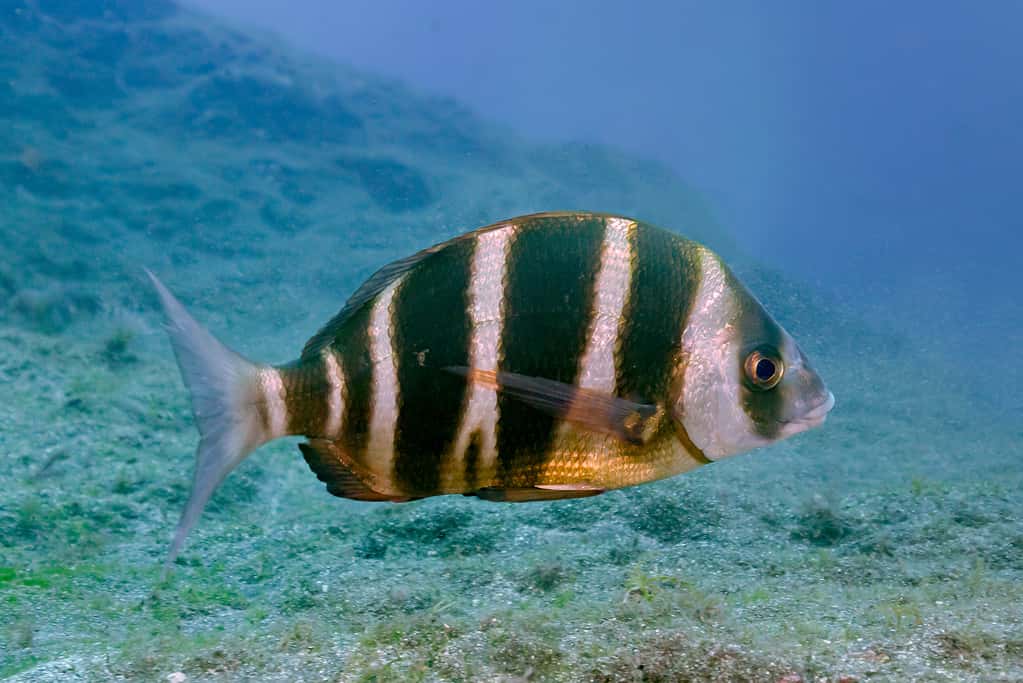
This zebra seabream was spotted in the Teno-Rasca marine strip, in Tenerife, Spain.
©Diego Delso / CC BY-SA 4.0 – License
This marine reef species is native to the Eastern Atlantic Ocean from the Bay of Biscay to South Africa, as well as the Mediterranean Sea. It is omnivorous, feeding on both small invertebrates and seaweeds, and can grow up to 55.0 cm TL. It is also subject to sport fishing in its native range.
30. Zebra Seahorse (Hippocampus zebra)
This marine species is endemic to the coastal waters of northern Australia. Like other seahorses, it is ovoviviparous, with males carrying the eggs and then hatching live young. It can grow to 8.0 cm.
31. Zebra Shark (Stegostoma tigrinum)
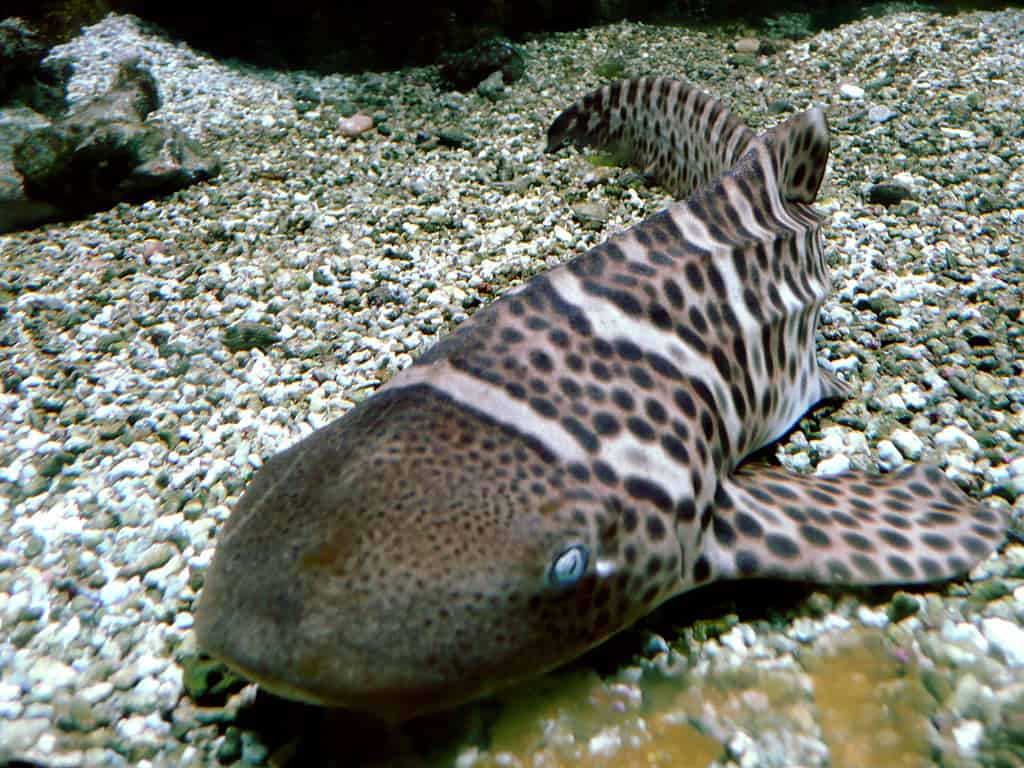
This juvenile zebra shark is in the process of changing out of its baby stripes and into its adult spots!
©Liné1 / CC BY-SA 3.0 – License
This marine and brackish reef-associated shark is native to the Indo-West Pacific region, including the Red Sea and Persian Gulf. While this species is named for the striped pattern of the young, the adults have quite different spotted patterns. This led to them originally being mistaken for two separate species! It can potentially grow up to 354 cm TL, making it the biggest fish on this list. The IUCN also currently lists this species as Endangered.
32. Zebra Shovelnose (Brachyplatystoma tigrinum)
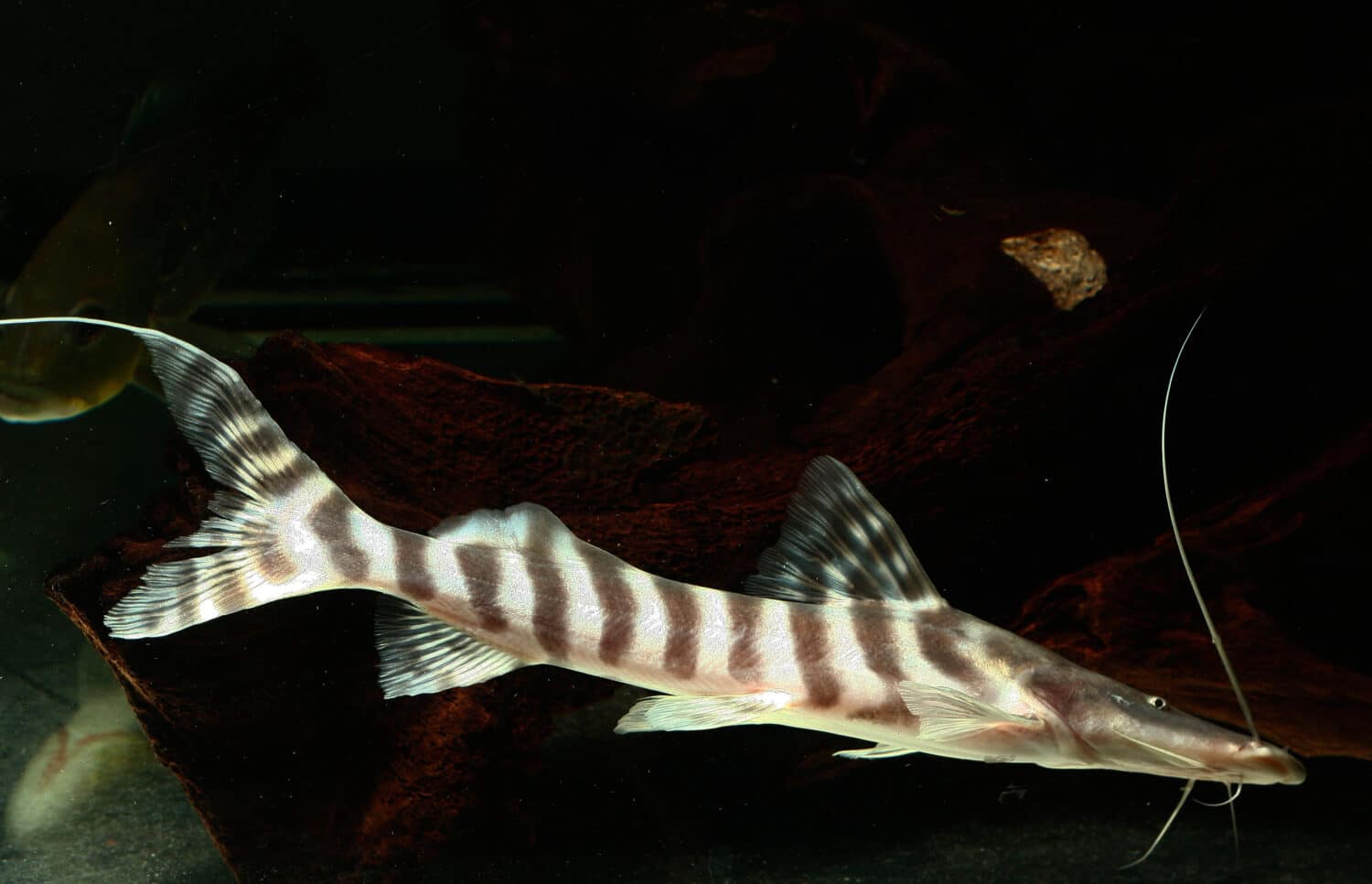
The zebra shovelnose is yet another of the zebra-patterned catfish species.
©Pavaphon Supanantananont/Shutterstock.com
This freshwater tropical catfish is native to the Amazon River basin in South America. It is a predatory species that eats other fishes, and it can grow up to 60.0 cm TL.
33. Zebra Spiny Eel (Macrognathus zebrinus)

This vintage photo of a zebra Spiny Eel is from
Fauna of British India(1899).
©George Henry Ford (1808–1876) / CC0 – License
This freshwater tropical species is endemic to the Irrawaddy, Sittang, and Salween Rivers in Myanmar, and may also occur in Indonesia. Furthermore, it has been introduced into reservoirs in Singapore. It feeds on both small invertebrates and fishes and can grow up to 46.0 cm TL.
34. Zebra Sweetlip (Plectorhinchus paulayi)
This marine tropical reef grunt is native to the Western Indian Ocean near Somalia, Kenya, and both the Aldabra and Mauritius islands. It inhabits both shallow inshore waters and seaward reef slopes and can grow up to 45.0 cm TL.
35. Zebra Sole (Zebrias zebra)
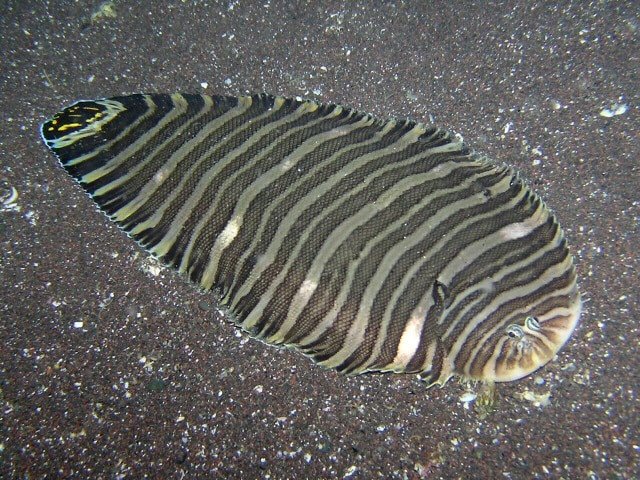
The zebra sole could pass as a zebra rug!
©Izuzuki / CC BY-SA 3.0 – License
This marine and brackish reef-associated flatfish is native to the Western Pacific from the Gulf of Thailand to southern Japan, the Philippines, Borneo, and Indonesia, where it can grow to 26.0 cm TL. It is also fished commercially.
36. Zebra Tilapia (Heterotilapia buttikoferi)

This zebra tilapia is on display at an aquarium in Italy.
©Hectonichus / CC BY-SA 3.0 – License
This freshwater tropical cichlid is native to larger coastal rivers in West Africa. It is primarily herbivorous and can grow up to 30.8 cm SL.
37. Zebra Tilefish (Branchiostegus semifasciatus)
This marine tropical species is native to the Eastern Atlantic Ocean from Casablanca, Morocco to Baia dos Tigres, Angola. It can eventually grow up to 60.0 cm TL. It is also fished commercially.
38. Zebrette Goby (Tigrigobius zebrellus)
This tropical marine reef species is native to the southern Caribbean Sea around both Venezuela and Trinidad, where it can grow to 2.0 cm.
39. Zelinda’s Parrotfish (Scarus zelindae)
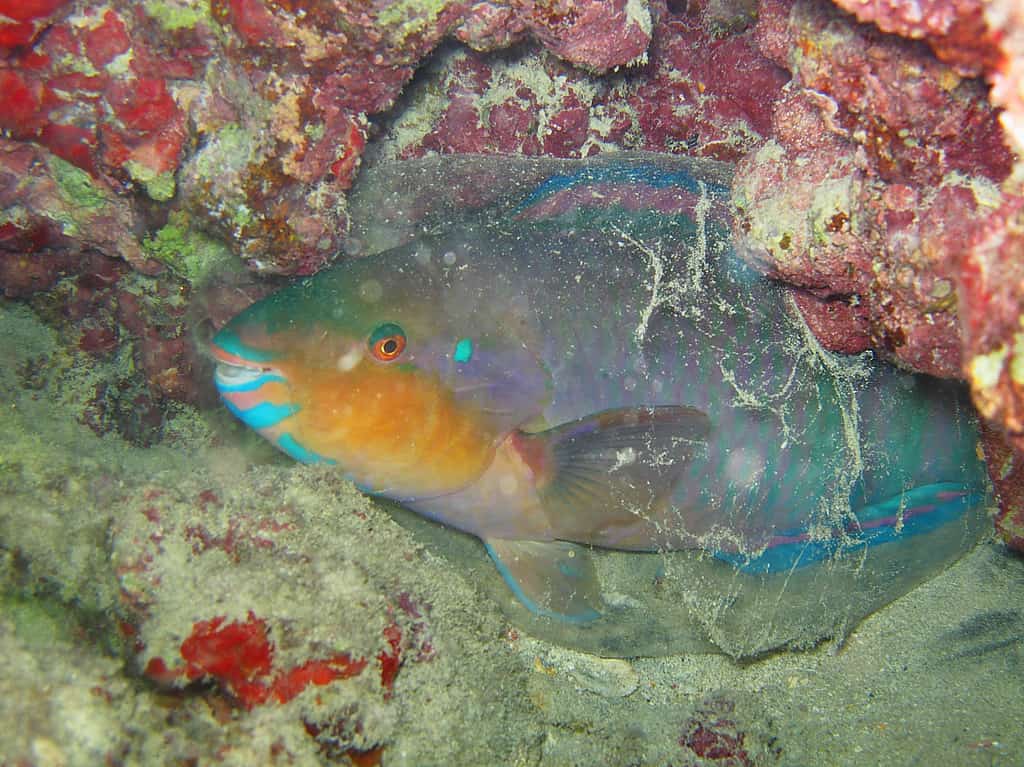
Zelinda’s parrotfish makes a mucous bubble “sleeping bag” for itself!
©Igor Cristino Silva Cruz / CC BY-SA 4.0 – License
This marine tropical reef species is endemic to the Southwestern Atlantic Ocean around Brazil. Like many parrotfish species, it is a sequential hermaphrodite of the protogynous variety. What this means is that fish born female can subsequently turn male later in life. (See #45 below for another example.) This parrotfish also helps create the region’s famous white sand beaches — the digestive process breaks down hard coral bits and excretes them as that sand! It can grow up to 33.2 cm SL.
40. Zeravshan Dace (Leuciscus lehmanni)
This freshwater temperate minnow is native to both Afghanistan and Uzbekistan, where it can grow to 20.4 cm SL.
41. Zhobi Mahseer (Naziritor zhobensis)
This freshwater temperate cyprinid is endemic to rivers in Pakistan, where it can grow up to 32.3 SL. The IUCN also currently lists this species as Endangered.
42. Ziege (Pelecus cultratus)
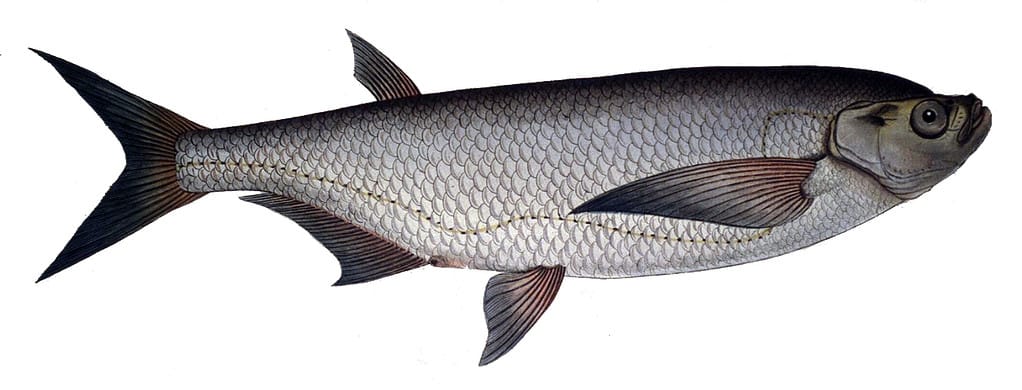
The ziege has a notably wavy lateral line traversing its lower body.
©Krüger / CC0 – License
This freshwater and brackish temperate minnow is native to the Baltic, Black, Caspian, and Aral Sea basins of Eurasia. It feeds on zooplankton and invertebrates as well as small fish, and can eventually grow up to 60.0 cm TL.
43. Ziegler’s Triplefin (Enneapterygius ziegleri)
This tropical marine reef triplefin blenny is native to the Indo-West Pacific region around the Timor Sea, Indonesia, and East Timor, as well as the Philippines, where it can grow to 3.1 cm SL.
44. Zigzag Barb (Enteromius miolepis)
This freshwater tropical species is native throughout the Congo River basin as well as neighboring river systems across central Africa, where it can grow to 12.5 cm SL. It is also found in the aquarium trade.
45. Zigzag Wrasse (Halichoeres scapularis)
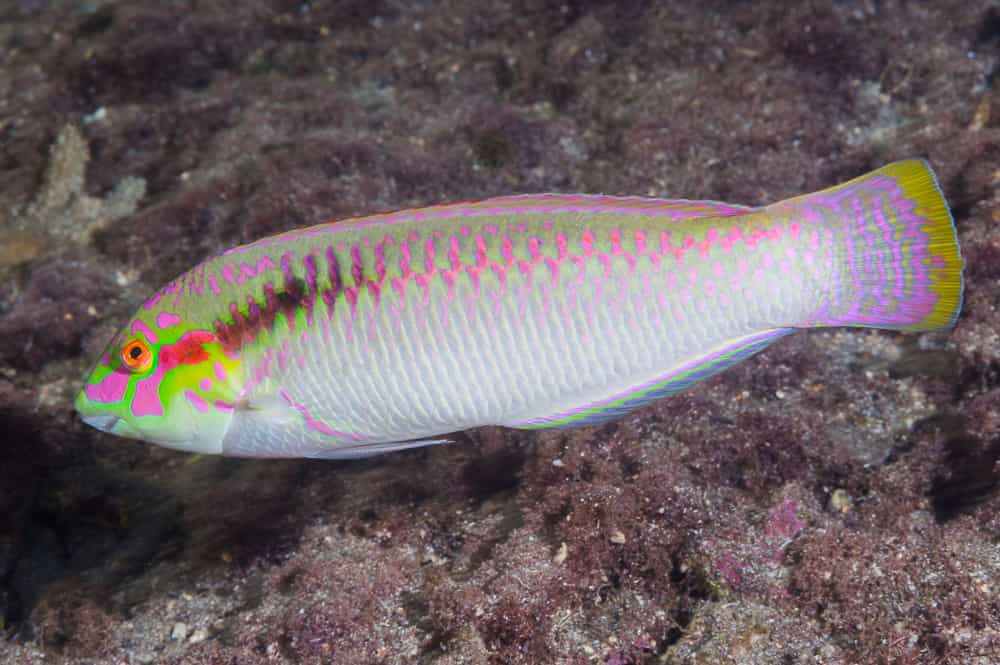
This zigzag wrasse is in its terminal (male) phase.
©Francois Libert / CC BY-SA 2.0 – License
This tropical marine reef species is native to the Indo-West Pacific region, including the Red Sea. Like many wrasse species, it is a sequential hermaphrodite of the protogynous variety, with females capable of subsequently changing into males later in life (see #39 above for another example). It feeds on benthic small crustaceans and can grow to 20.0 cm TL. It is also available in the aquarium trade.
46. Zingel (Zingel zingel)

This zingel was collected from the Tisza River in Hungary.
©Harka, Akos / CC BY 3.0 – License
This freshwater temperate perch is endemic to the drainage basins of both the Danube and Dniestr Rivers in southeastern Europe. It is nocturnal, feeds on both aquatic invertebrates and small fishes, and can grow up to 48.0 cm SL.
47. Zipper Sand Skate (Psammobatis extenta)
This marine subtropical species is native to the Southwest Atlantic Ocean around Brazil, Uruguay, and Argentina, where it can grow to 27.6 cm TL.
48. Zonetail Butterfly Ray (Gymnura zonura)
This marine tropical reef ray is native to both the Eastern Indian Ocean and Western Central Pacific from India to Indonesia, Singapore, and Thailand. It can eventually grow up to a width of 106 cm. The IUCN also currently lists this species as Endangered.
49. Zucchini Catfish/Pleco (Isorineloricaria spinosissim)

This zucchini catfish specimen has a stunning spotted pattern.
©Krlossba / CC BY-SA 4.0 – License
This freshwater tropical species is endemic to the Guayas River basin in Ecuador, where it can grow up to 56.0 cm TL.
50. Zugmayer’s Pearleye (Benthalbella infans)
This marine deep-sea species is widespread across both the tropical and subtropical Atlantic, Indian and Pacific Oceans. This is a predatory species that feeds on other fishes and can grow to 13.8 cm SL.
51. Zulu Snakelet (Halimuraena shakai)
This marine reef eel-blenny is native to the Western Indian Ocean around South Africa, Comoros, and Mauritius, where it can grow to 6.0 cm TL.
52. Zuni Bluehead Sucker (Catostomus discobolus jarrovii)
This temperate freshwater fish is an endangered subspecies of the bluehead sucker that is endemic to streams in Arizona and New Mexico. It feeds by scraping both algae and invertebrates off rocks and can grow to 41.0 cm TL. While it has not been evaluated by the IUCN, it is listed as Endangered on the United States Endangered Species List. Furthermore, it is considered New Mexico’s most endangered fish species.
Summary of Fish That Start with Z
| Common Name | Scientific Name | Geography | Conservation Status |
|---|---|---|---|
| Zabaleta Anchovy | Anchovia clupeoides | W Atlantic from Gulf of Mexico, Caribbean, & Central and South American coast to Brazil | LC |
| Zaca Blenny | Malacoctenus zacae | Pacific coast of Mexico from Baja California to Acapulco | LC |
| Zacapu Allotoca | Allotoca zacapuensis | Zacapu, Michoacán, Mexico | CR |
| Zaire Lampeye | Hypsopanchax platysternus | middle & upper Congo River basin in Africa | LC |
| Zambezi Bream | Pharyngochromis acuticeps | river systems in southern Africa | LC |
| Zambezi Grunter | Parauchenoglanis ngamensis | Kasai, Okavango, & upper Zambesi River systems in central & southern Africa | LC |
| Zambezi Happy | Pharyngochromis darlingi | Okavango, upper Save-Runde, Zambezi, & Kunene River systems in southern Africa | NE |
| Zambezi Parrotfish | Cyphomyrus discorhynchus | river & lake systems across central & southern Africa | LC |
| Zamora Woodcat | Auchenipterichthys coracoideus | Amazon River basin in Peru | LC |
| Zamurito | Calophysus macropterus | Amazon & Orinoco River basins in South America | NE |
| Zander | Sander lucioperca | Caspian, Baltic, Black & Aral Sea basins; Elbe (North Sea basin) & Maritza (Aegean Sea basin) drainages; introduced widely elsewhere | LC |
| Zanzibar Barb | Enteromius zanzibaricus | rivers of Kenya & Somaliland in Africa | LC |
| Zanzibar Butterflyfish | Chaetodon zanzibarensis | W Indian Ocean from eastern to southern Africa, Madagascar, other nearby oceanic islands | LC |
| Zanzibar Guitarfish | Rhinobatos zanzibarensis | W Indian Ocean in the inner continental shelf around Tanzania | NT |
| Zanzibar Tonguesole | Cynoglossus zanzibarensis | W Indian Ocean in shallow waters from Kenya to South Africa | LC |
| Zavora Pipefish | Halicampus zavorensis | W Indian Ocean around Mozambique & Oman | DD |
| Zebra Blenny aka Zebra Rockskipper | Istiblennius zebra | tidepools of the Hawaiian Islands | LC |
| Zebra Bullhead Shark | Heterodontus zebra | W Pacific from Japan & Korea to NW Australia & Queensland | LC |
| Zebra Catfish | Brachyplatystoma juruense | Amazon & Orinoco River basins in South America | NE |
| Zebra Clingfish | Tomicodon zebra | E Central Pacific from southern Baja California & eastern Gulf of California (including Tres Marias Islands) to southern Mexico | LC |
| Zebrafish aka Zebra Danio | Danio rerio | South Asia: Pakistan, India, Pakistan Bangladesh, Nepal, Myanmar, Bhutan; also introduced in U.S. & Columbia | LC |
| Zebra Garden Eel | Heteroconger polyzona | Indo-West Pacific region, including Ryukyu Islands, Philippines, Indonesia, Papua New Guinea, Vanuatu | LC |
| Zebra Lionfish aka Zebra Turkeyfish | Dendrochirus zebra | Indo-West Pacific region, including Red Sea | LC |
| Zebra Loach | Botia striata | Western Ghats & Maharashtra, India | EN |
| Zebra Moray | Gymnomuraena zebra | Indo-Pacific region (widespread) | LC |
| Zebra Oto | Otocinclus cocama | rivers in Peru | EN |
| Zebra Perch Sea Chub | Kyphosus azureus | E Central Pacific from Monterey Bay (California, USA) to the Gulf of California (Mexico) | LC |
| Zebra Pleco | Hypancistrus zebra | Xingu River basin in Brazil | CR |
| Zebra Seabream | Diplodus cervinus | E Atlantic from Bay of Biscay to South Africa; Mediterranean Sea | LC |
| Zebra Seahorse | Hippocampus zebra | coastal waters of northern Australia | DD |
| Zebra Shark | Stegostoma tigrinum | Indo-West Pacific region, including Red Sea & Persian Gulf | EN |
| Zebra Shovelnose | Brachyplatystoma tigrinum | Amazon River basin in South America | NE |
| Zebra Spiny Eel | Macrognathus zebrinus | Irrawaddy, Sittang, and Salween Rivers in Myanmar; possibly also Indonesia | LC |
| Zebra Sweetlip | Plectorhinchus paulayi | W Indian Ocean near Somalia, Kenya, Aldabra, Mauritius | LC |
| Zebra Sole | Zebrias zebra | W Pacific from Gulf of Thailand to southern Japan, Philippines, Borneo, Indonesia | NE |
| Zebra Tilapia | Heterotilapia buttikoferi | larger coastal rivers of western Africa | LC |
| Zebra Tilefish | Branchiostegus semifasciatus | E Atlantic from Casablanca, Morocco to Baia dos Tigres, Angola | LC |
| Zebrette Goby | Tigrigobius zebrellus | S Caribbean around Venezuela & Trinidad | LC |
| Zelinda’s Parrotfish | Scarus zelindae | SW Atlantic around Brazil | DD |
| Zeravshan Dace | Leuciscus lehmanni | Afghanistan, Uzbekistan | LC |
| Zhobi Mahseer | Naziritor zhobensis | rivers in Pakistan | EN |
| Ziege | Pelecus cultratus | Baltic, Black, Caspian, & Aral Sea basins of Eurasia | LC |
| Ziegler’s Triplefin | Enneapterygius ziegleri | Indo-West Pacific around the Timor Sea, Indonesia, East Timor, Philippines | LC |
| Zigzag Barb | Enteromius miolepis | throughout the Congo River basin and neighboring river systems across central Africa | LC |
| Zigzag Wrasse | Halichoeres scapularis | Indo-West Pacific region, including Red Sea | LC |
| Zingel | Zingel zingel | drainage basins of the Danube and Dniestr Rivers in SE Europe | LC |
| Zipper Sand Skate | Psammobatis extenta | SW Atlantic around Brazil, Uruguay, Argentina | LC |
| Zonetail Butterfly Ray | Gymnura zonura | E Indian Ocean & W Central Pacific from India to Indonesia, Singapore, Thailand | EN |
| Zucchini Catfish/Pleco | Isorineloricaria spinosissima | Guayas River basin in Ecuador | LC |
| Zugmayer’s Pearleye | Benthalbella infans | tropical & subtropical Atlantic, Indian, and Pacific Oceans | LC |
| Zulu Snakelet | Halimuraena shakai | W Indian Ocean around South Africa, Comoros, and Mauritius | LC |
| Zuni Bluehead Sucker | Catostomus discobolus jarrovii | streams in Arizona & New Mexico, USA | NE (Endangered in USA) |
NE = Not Evaluated, DD = Data Deficient, LC = Least Concern, NT = Near Threatened, VU = Vulnerable, EN = Endangered, CR = Crticially Endangered, EW = Extinct in the Wild, EX = Extinct
The photo featured at the top of this post is © Kazakov Maksim/Shutterstock.com
Thank you for reading! Have some feedback for us? Contact the AZ Animals editorial team.






